Flies and other nuisances
Bunbury - Cape Naturaliste - Leeuwin NP
Click on a picture to enlarge. These pages show only a small selection of the 400 pictures of Australia. Order the CD to view all pictures full screen (800 x 600 pixels) and to enjoy the slide shows with original music! The CD offers you also the complete interactive story, suitable for quick viewing and printing.
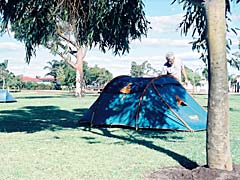 Nobody
told us about the flies. You think the Aboriginals are the dark secret of Australia?
Wrong. The flies are. Nobody ever tells the tourist about the flies. Don’t you
dare talk about it to anyone! In Perth it wasn’t so bad. Only now and then a
fly suddenly appeared, usually stubbornly sticking in the middle of the face
of a guide, closely surrounded by a group of tourist who thought they spoke
English but can’t understand a word of his rapid spoken totally unarticulated
story. ‘Poor guide’ we thought when the fly – in spite of desperate hand waving
gestures - refused to leave his face for longer than a couple of seconds. Once
we left Perth and headed for the south the flies slowly started to multiply.
Nobody
told us about the flies. You think the Aboriginals are the dark secret of Australia?
Wrong. The flies are. Nobody ever tells the tourist about the flies. Don’t you
dare talk about it to anyone! In Perth it wasn’t so bad. Only now and then a
fly suddenly appeared, usually stubbornly sticking in the middle of the face
of a guide, closely surrounded by a group of tourist who thought they spoke
English but can’t understand a word of his rapid spoken totally unarticulated
story. ‘Poor guide’ we thought when the fly – in spite of desperate hand waving
gestures - refused to leave his face for longer than a couple of seconds. Once
we left Perth and headed for the south the flies slowly started to multiply.
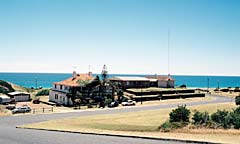
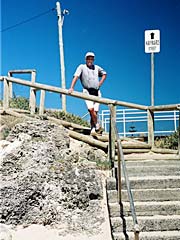 But
first we need a car. In Holland we reserved a rental car via internet, very
expensive, renting a car when you start or end in West Australia costs at least
twice more then renting a car for driving around in South Australia, Victoria
and New South Wales. So unfair we thought, we won’t drive any bad roads, we
aren’t heading for the deserted North of West Australia so why we have to pay
so much. After a couple of weeks we had somewhat more understanding and you
will also – be patient. It was a lot of money, but at least everything is paid
for. Or so we thought. When we complete the paper work, the rental company informs
us that we are only partly insured, each accident will cost us 1000 Australian
Dollars (€ 600) – even if the accident is not our fault, in that case we get
the money back when the insurance of the other party pays. When we want to be
fully insured we have to pay another large amount of money. We have a tight
budget and never damaged any rental car so we keep our money and take the risk.
But
first we need a car. In Holland we reserved a rental car via internet, very
expensive, renting a car when you start or end in West Australia costs at least
twice more then renting a car for driving around in South Australia, Victoria
and New South Wales. So unfair we thought, we won’t drive any bad roads, we
aren’t heading for the deserted North of West Australia so why we have to pay
so much. After a couple of weeks we had somewhat more understanding and you
will also – be patient. It was a lot of money, but at least everything is paid
for. Or so we thought. When we complete the paper work, the rental company informs
us that we are only partly insured, each accident will cost us 1000 Australian
Dollars (€ 600) – even if the accident is not our fault, in that case we get
the money back when the insurance of the other party pays. When we want to be
fully insured we have to pay another large amount of money. We have a tight
budget and never damaged any rental car so we keep our money and take the risk.

Luckily our car – a Toyota Corolla - is an automatic and the
traffic in Perth is very relaxed, 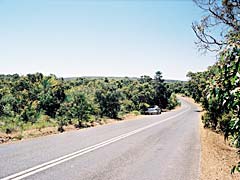 so
we survive the first day of driving on the left side of the road. It is not
difficult to find the way from Perth to Bunbury, which is a good thing since
every time I’m a bit late announcing a change of direction I’m startled by the
windscreen wipers, suddenly moving like crazy. I look at Jac and see he is trying
every handle in a desperate attempt to find the right one. Everything is mirrored
in this car, so it happens quite often that Jac enters our car at the left side,
keys ready, just to find me next to him behind the steering wheel. Very funny!
Not so funny however is that I still open my new Toyota Corolla on the right
(but not the right) side, two months later in Holland…
so
we survive the first day of driving on the left side of the road. It is not
difficult to find the way from Perth to Bunbury, which is a good thing since
every time I’m a bit late announcing a change of direction I’m startled by the
windscreen wipers, suddenly moving like crazy. I look at Jac and see he is trying
every handle in a desperate attempt to find the right one. Everything is mirrored
in this car, so it happens quite often that Jac enters our car at the left side,
keys ready, just to find me next to him behind the steering wheel. Very funny!
Not so funny however is that I still open my new Toyota Corolla on the right
(but not the right) side, two months later in Holland…
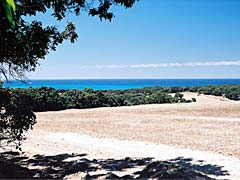
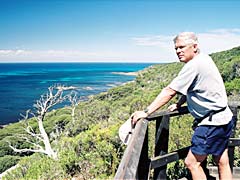 Bunbury
is a small town, closed in by the Indian Ocean on the west and Koombana Bay
on the north side. We camp close to Koombana Bay, a spacious camping with lots
of green grass and almost no visitors, just like camping in a park. The weather
is nice and early the next morning we go to the ‘Dolphin Interaction Zone’ to
try swimming with dolphins. We lay on the beach for a couple of hours, talk
with dolphin volunteers, see some bottlenose dolphins jumping around but far
away and at last take a swim anyway, dolphins or no dolphins. The next day we
are luckier, just before leaving we see some dolphins a little further away.
I start swimming and suddenly one jumps out of the water quite close to me,
only a couple of meters. I follow the dolphin but this is no use, from a boat
you can see how fast they swim but once you’re in the water together with one
you especially notice how incredibly slow you swim yourself!
Bunbury
is a small town, closed in by the Indian Ocean on the west and Koombana Bay
on the north side. We camp close to Koombana Bay, a spacious camping with lots
of green grass and almost no visitors, just like camping in a park. The weather
is nice and early the next morning we go to the ‘Dolphin Interaction Zone’ to
try swimming with dolphins. We lay on the beach for a couple of hours, talk
with dolphin volunteers, see some bottlenose dolphins jumping around but far
away and at last take a swim anyway, dolphins or no dolphins. The next day we
are luckier, just before leaving we see some dolphins a little further away.
I start swimming and suddenly one jumps out of the water quite close to me,
only a couple of meters. I follow the dolphin but this is no use, from a boat
you can see how fast they swim but once you’re in the water together with one
you especially notice how incredibly slow you swim yourself!

We visit the ‘Big Swamp Wildlife Park’ in Bunbury and hand
feed the red kangaroos. The park is 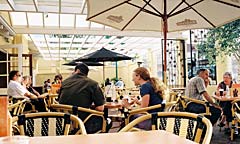 empty
and the kangaroos are hungry, so we are very popular guests. Some kangaroos
catch your hand and don’t let go till it’s empty, others go straight for the
food packet. This sounds a bit aggressive but no, these kangaroos are cuddlesome
and love to be chucked under the chin. A very nice experience! The park also
shows native birds we’ll later see in abundance: Lorikeets (which we also feed),
Parrots, Corellas, Cockatoos (careful, they bite), Black Swans, Magpie Geese
and the strange looking Kookaburras.
empty
and the kangaroos are hungry, so we are very popular guests. Some kangaroos
catch your hand and don’t let go till it’s empty, others go straight for the
food packet. This sounds a bit aggressive but no, these kangaroos are cuddlesome
and love to be chucked under the chin. A very nice experience! The park also
shows native birds we’ll later see in abundance: Lorikeets (which we also feed),
Parrots, Corellas, Cockatoos (careful, they bite), Black Swans, Magpie Geese
and the strange looking Kookaburras.

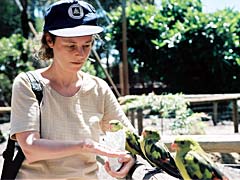 From
Bunbury we drive further south to Cape Naturaliste. First we drive through open
fields, but then the road narrows and the scenery gets wilder,
From
Bunbury we drive further south to Cape Naturaliste. First we drive through open
fields, but then the road narrows and the scenery gets wilder, 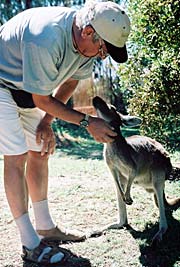 trees
surrounded by flowering brushwood, undulating landscape and then suddenly a
far away blue glimpse of the ocean in between all the green. Cape Naturaliste,
pointing westwards into the Indian Ocean, is a beautiful place with its wide
views over the green country and the transparent blue sea sparkling with azure
stripes. We walk to the whale watch point where you can see far away over the
ocean. Alas - no whales to be seen but only about a million flies. The temperature
suddenly rises to 30 °C and the flies are everywhere: in our eyes, our ears,
our nose, our mouth. Strange flies here in Australia, in Holland they go for
the food but here a fly is only interested in your face.
trees
surrounded by flowering brushwood, undulating landscape and then suddenly a
far away blue glimpse of the ocean in between all the green. Cape Naturaliste,
pointing westwards into the Indian Ocean, is a beautiful place with its wide
views over the green country and the transparent blue sea sparkling with azure
stripes. We walk to the whale watch point where you can see far away over the
ocean. Alas - no whales to be seen but only about a million flies. The temperature
suddenly rises to 30 °C and the flies are everywhere: in our eyes, our ears,
our nose, our mouth. Strange flies here in Australia, in Holland they go for
the food but here a fly is only interested in your face.
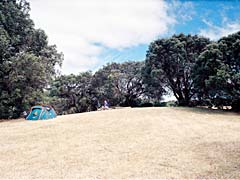
Fifty kilometer to the south we camp in Leeuwin Naturaliste
Park. Our camping, Conto Beach, 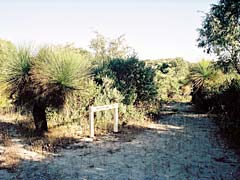 consists
of a big stretch of wild country and is almost deserted. We take our time looking
around for a good place and choose a position close to a toilet and not to far
away from the only water point. We are not yet very experienced Australian campers
and think camping close to a couple of trees will protect us sufficiently against
the wind. Somehow we manage to camp on the highest point of the whole camping
and at night I hear the wind: the noise starting far away up in the sky, gathering
strength like a roller in the surf, hitting
consists
of a big stretch of wild country and is almost deserted. We take our time looking
around for a good place and choose a position close to a toilet and not to far
away from the only water point. We are not yet very experienced Australian campers
and think camping close to a couple of trees will protect us sufficiently against
the wind. Somehow we manage to camp on the highest point of the whole camping
and at night I hear the wind: the noise starting far away up in the sky, gathering
strength like a roller in the surf, hitting 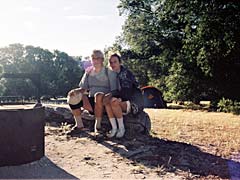 the
tops of the highest trees, screaming in the lower trees and finally wrenching
our tent. I lie awake, wondering when our tent will give up. But nothing happens
and early in the morning the wind calms down a bit. That is the sign for the
lorikeets. First I hear only a couple of them in trees far away, suddenly the
noise is deafening and big flocks of lorikeets terrorize our tent. I’m sure
the amount of decibels is far above the acceptable level, but since this is
nature nothing is to be done. Later on they settle down and when I look outside
our tent I see groups of green and red lorikeets eating in the grass.
the
tops of the highest trees, screaming in the lower trees and finally wrenching
our tent. I lie awake, wondering when our tent will give up. But nothing happens
and early in the morning the wind calms down a bit. That is the sign for the
lorikeets. First I hear only a couple of them in trees far away, suddenly the
noise is deafening and big flocks of lorikeets terrorize our tent. I’m sure
the amount of decibels is far above the acceptable level, but since this is
nature nothing is to be done. Later on they settle down and when I look outside
our tent I see groups of green and red lorikeets eating in the grass.
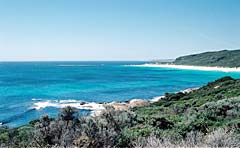
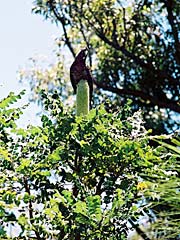 During
breakfast Jac explicates to me the minimum facilities a camping must offer to
become a ‘Jacques approved camping’. A beautiful situation is ranked as nice,
but certainly not as sufficient! A clean toilet (Jac means with this a toilet
without ants), a shower and a kitchen to have a place to cook, a little light
in the evening and some protection against the wind (our romantic fire last
night almost destroyed the whole camping) are deemed essential. Normally I prepare
the traveling route – Jac
During
breakfast Jac explicates to me the minimum facilities a camping must offer to
become a ‘Jacques approved camping’. A beautiful situation is ranked as nice,
but certainly not as sufficient! A clean toilet (Jac means with this a toilet
without ants), a shower and a kitchen to have a place to cook, a little light
in the evening and some protection against the wind (our romantic fire last
night almost destroyed the whole camping) are deemed essential. Normally I prepare
the traveling route – Jac 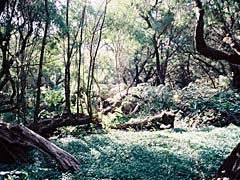 doesn’t
like to see pictures beforehand, why visit the country when you have seen everything
already – but now he thinks it wise to take a closer look at my camping plans.
I have to admit washing up here is not very easy: you need one hand to keep
the tap running, one hand to hold the object to be washed, one to remove the
dirt and at least two hands to remove the flies from your face. Some kind of
gad-fly seems to like only my blood, Jac anyway is so busy with the other flies
he doesn’t notice anything any more.
doesn’t
like to see pictures beforehand, why visit the country when you have seen everything
already – but now he thinks it wise to take a closer look at my camping plans.
I have to admit washing up here is not very easy: you need one hand to keep
the tap running, one hand to hold the object to be washed, one to remove the
dirt and at least two hands to remove the flies from your face. Some kind of
gad-fly seems to like only my blood, Jac anyway is so busy with the other flies
he doesn’t notice anything any more.
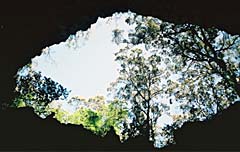
 We
walk through the bush to the nearby caves. The temperature is very nice and
the trees protect us against the sun. We see strange looking trees, a kind of
small palm tree with a punk hairdo on top. Later on I hear they are
We
walk through the bush to the nearby caves. The temperature is very nice and
the trees protect us against the sun. We see strange looking trees, a kind of
small palm tree with a punk hairdo on top. Later on I hear they are 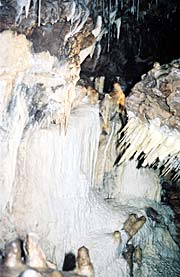 named
grass trees and flower only after being burned in a bushfire – usually they
don’t have to wait long I guess. Big black cockatoos with silver ribbons on
their chest watch us from close by, they seem even more interested in us than
vice versa. We find the caves easily after only a short stroll (things cannot
always be difficult, sorry). The entrance of the so called ‘Lake Cave’ is very
special, a former cave has collapsed and we descend a staircase to the bottom
of the former cave. Enormous karri trees grow up to the light. Down here the
rocks are moss-grown and the temperature is a couple of degrees lower. Lake
Cave is a high cave with stalagmites and stalactites, reflected in the
named
grass trees and flower only after being burned in a bushfire – usually they
don’t have to wait long I guess. Big black cockatoos with silver ribbons on
their chest watch us from close by, they seem even more interested in us than
vice versa. We find the caves easily after only a short stroll (things cannot
always be difficult, sorry). The entrance of the so called ‘Lake Cave’ is very
special, a former cave has collapsed and we descend a staircase to the bottom
of the former cave. Enormous karri trees grow up to the light. Down here the
rocks are moss-grown and the temperature is a couple of degrees lower. Lake
Cave is a high cave with stalagmites and stalactites, reflected in the 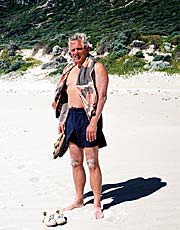 tranquil
water of a big under earth lake. The quiet, mysterious atmosphere of the cave
forms a big contrast with the hot, green bush full of life a hundred meter higher.
tranquil
water of a big under earth lake. The quiet, mysterious atmosphere of the cave
forms a big contrast with the hot, green bush full of life a hundred meter higher.
Conto Beach is close by and looks very inviting: dazzling white
sand and blue water with fair tops. On the picture you see Jac happily standing
in the sun on the beach. However, the reality is slightly different. Jac, normally
very quiet, is well on his way with his second tirade of today: “The wind is
sandblasting me, troops of sticky flies are harassing me, the sun burns, the
surf is extremely dangerous and the water is ice cold!”. I can’t help noticing
that finally Jac understands the difference between looking at a picture and
experiencing a place. ‘Yes’, he agrees: ‘The flies’.

Back to Virtual Traveling home
 Nobody
told us about the flies. You think the Aboriginals are the dark secret of Australia?
Wrong. The flies are. Nobody ever tells the tourist about the flies. Don’t you
dare talk about it to anyone! In Perth it wasn’t so bad. Only now and then a
fly suddenly appeared, usually stubbornly sticking in the middle of the face
of a guide, closely surrounded by a group of tourist who thought they spoke
English but can’t understand a word of his rapid spoken totally unarticulated
story. ‘Poor guide’ we thought when the fly – in spite of desperate hand waving
gestures - refused to leave his face for longer than a couple of seconds. Once
we left Perth and headed for the south the flies slowly started to multiply.
Nobody
told us about the flies. You think the Aboriginals are the dark secret of Australia?
Wrong. The flies are. Nobody ever tells the tourist about the flies. Don’t you
dare talk about it to anyone! In Perth it wasn’t so bad. Only now and then a
fly suddenly appeared, usually stubbornly sticking in the middle of the face
of a guide, closely surrounded by a group of tourist who thought they spoke
English but can’t understand a word of his rapid spoken totally unarticulated
story. ‘Poor guide’ we thought when the fly – in spite of desperate hand waving
gestures - refused to leave his face for longer than a couple of seconds. Once
we left Perth and headed for the south the flies slowly started to multiply.



















